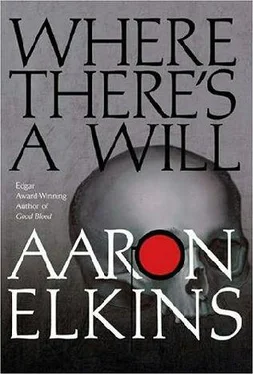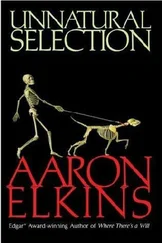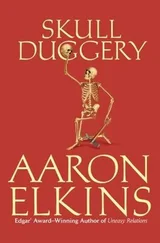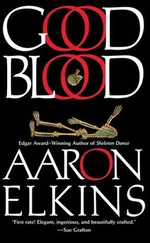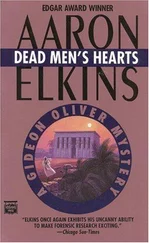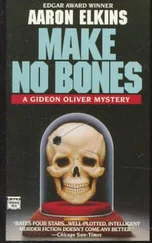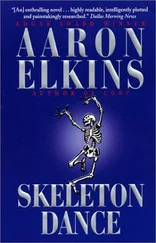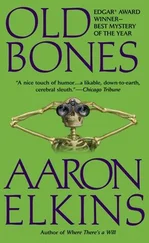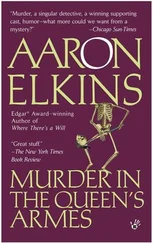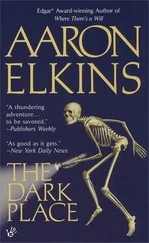Aaron Elkins - Where there's a will
Здесь есть возможность читать онлайн «Aaron Elkins - Where there's a will» весь текст электронной книги совершенно бесплатно (целиком полную версию без сокращений). В некоторых случаях можно слушать аудио, скачать через торрент в формате fb2 и присутствует краткое содержание. Жанр: Классический детектив, на английском языке. Описание произведения, (предисловие) а так же отзывы посетителей доступны на портале библиотеки ЛибКат.
- Название:Where there's a will
- Автор:
- Жанр:
- Год:неизвестен
- ISBN:нет данных
- Рейтинг книги:4 / 5. Голосов: 1
-
Избранное:Добавить в избранное
- Отзывы:
-
Ваша оценка:
- 80
- 1
- 2
- 3
- 4
- 5
Where there's a will: краткое содержание, описание и аннотация
Предлагаем к чтению аннотацию, описание, краткое содержание или предисловие (зависит от того, что написал сам автор книги «Where there's a will»). Если вы не нашли необходимую информацию о книге — напишите в комментариях, мы постараемся отыскать её.
Where there's a will — читать онлайн бесплатно полную книгу (весь текст) целиком
Ниже представлен текст книги, разбитый по страницам. Система сохранения места последней прочитанной страницы, позволяет с удобством читать онлайн бесплатно книгу «Where there's a will», без необходимости каждый раз заново искать на чём Вы остановились. Поставьте закладку, и сможете в любой момент перейти на страницу, на которой закончили чтение.
Интервал:
Закладка:
Ergo, he was looking at the mandible of a large-boned female. In her early- to mid-twenties. With an eating disorder.
Claudia Albert. And the fact-well, the high probability-that it was Claudia Albert added weight to the idea that Magnus Torkelsson had been aboard, too, even if nothing of him were to turn up.
All these observations had been made without benefit of measuring instruments, regression equations, or statistical tables, but he had been at this long enough to feel reasonably comfortable about his conclusions without them. The numbers and tables came in handy when you were trying to convince a jury or a skeptical defense lawyer that you knew what you were talking about, but Gideon, like most of his colleagues, trusted more to his instincts-that is, his educated and well-honed instincts-than anything that came out of a computer. Anyway, in this case, there were no lawyers or juries to worry about.
Drowsy with the heat, his back against a post, his head drooping, he sat musing over the mandible for a while. If she had lived, those third molars would have given her a lot of trouble. They were both impacted-tipped toward the second molars in front of them-so that when they had fully erupted they would have been pressing hard against them, putting a strain on the fabric of the entire mouth. Most likely, they would have had to come out.
Wisdom teeth, he reflected; one of those little mistakes that the evolutionary process makes, or rather one of those little lapses. What most people never seemed to get clear about the way evolution worked was that Mother Nature didn’t give much thought to the big picture. She fussed and tinkered with the details that caught her interest, and let the rest take care of themselves. Once the hominid brain-case began to expand and the snout to retreat a million and a half or so years ago, the new, shorter face had less and less room for its mouthful of big, grinding, crushing teeth. They began to be squeezed uncomfortably together, not that that bothered Mother Nature. She just kept on squeezing, and the third molars, being the last to erupt, were always being faced with a shortage of space by the time they got there, so that they started coming up sideways or back-to-front, or any which way they could.
The way she usually took care of annoying little problems like that was to let us solve them for ourselves. That is, if impacted, diseased wisdom teeth and unhealthy, crowded mouths got to be enough of a problem, people would die from them earlier than the general population did, and as a result their representation in the gene pool would diminish, and eventually, given enough time, the trait would die out and be no more. In other words, Mother Nature left it to us to work the bugs out of her program. (“Sort of like we do for Bill Gates,” a student had aptly remarked the previous quarter.)
In the case of third molars, we were obviously still going through the process-they seemed to be becoming rarer with time-but modern dentistry, well-intentioned as it might be, had complicated things.. .
He became aware that the Cessna’s engines had been chattering for a while, and, looking up, he saw that the plane was slowly motoring over the lagoon toward them again. Had he been dozing? Apparently so; John had returned from the lagoon without his noticing and was just finishing his second sandwich and crumpling up the plastic wrap.
“Welcome back,” John said. “Have a good snooze?”
“I was thinking,” Gideon said. “Turning things over in my mind.”
“Yeah, right. I always snore when I turn things over in my mind, too. Listen, I got a question. This girl, this pilot, she had bulimia, right?”
“Right, bulimia nervosa.”
“Which is where you make yourself throw up after you eat.”
“Mm-hm.” He yawned, scratched his back against the post, and straightened up.
“But she was supposed to be this big, strapping kid. Aren’t bulimics underweight?”
“Interestingly enough, no. They’re never very much underweight, and usually above average weight, actually. You see, they don’t do it all the time. They go on periodic binges where they overeat, then make themselves vomit. You’re thinking of anorexics, who starve themselves or make themselves throw up or take laxatives or whatever, but they do it day in, day out.”
John cocked an eyebrow. “They’re never underweight?”
“No.”
“Never?”
“No.”
“It’s impossible to have a bulimic who’s skinny?”
“That’s right, because technically you can’t be a bulimic and an anorexic at the same time, so if a bulimic is morbidly underweight, she’s automatically classified as having anorexia, not bulimia.”
John, who had thought he was closing in for a rare Socratic kill, was clearly disappointed. “That’s… but that’s…”
“That is a salutary example of one of the tools of modern science,” Gideon said. “We experts use it all the time. It’s known as disposing of nonconforming data by means of semantic recategorization.”
“Science,” John said, shaking his head. “It’s wunnerful.”
“Hey, we’re done!” one of the brothers yelled from the plane as it neared the pier. “Got some good stuff for you.”
Gideon got up, stretched, swished some water around his dry mouth, and went with John to meet them. This time they tied up and Lyle quickly climbed down holding a small mesh basket. “Possible personal effects,” he said.
In the basket were the bent, lens-less frame of a pair of wire-rimmed glasses; a few coins-two quarters, a dime, a penny; a lidded coffee mug with a hula dancer on it; an enameled metal tourist souvenir, probably a trivet or a wall ornament, in the shape of the Big Island, complete with its two white-capped volcanic peaks in relief; a black plastic comb; and the rubber heel of a boot or shoe.
The Big Island souvenir was snarled in a crumpled tangle of gray duct tape, which Gideon picked at and managed to unstick.
“Amazing,” he said. “This stuff really does last forever.”
“That and Twinkies,” said John.
Some of the metal objects had a layer of green patina on them, but otherwise everything was in fairly good condition, and the ornament, the mug, and the glasses could well turn out to be helpful in identification. No bones, however, and Gideon had a hard time hiding his disappointment. “Well, this is good,” he said. “Somebody might remember some of this. See anything you recognize, John?”
John fingered the glasses. “These, maybe,” he said doubtfully. “I don’t know.”
“We can do better than that, prof,” Harvey said, jumping down onto the pier. “Lookee here, what we found jammed down under the right rudder pedal on the co-pilot’s side.” In his hand was a sodden, water-blackened cowboy boot, swollen and distorted, and missing its heel, but with the intricate stitching still in place. “You’ll love this.”
“A boot?”
“No, no, boot-shmoot, take a peek inside.” He tipped it so that Gideon could look into the top.
And there, nestled deep within, was the skeleton of a right foot, or at least all that could be seen of it: the talus and the calcaneus, the two uppermost bones of the human ankle and foot. There was little doubt that the rest of the foot was there, too. The bulky talus and calcaneus, their anatomical relations to each other only minimally disturbed, blocked the opening, and with the leather whole and the sole of the boot still attached, there was no place for the other bones to go.
“Hey, how about that?” he said, his enthusiasm reviving. The twenty-six bones of the foot and ankle were far from the most useful parts of the skeleton when it came to ageing, sexing, and so on (given his druthers he’d naturally have chosen a skull or pelvis or even a femur), but he had long ago found that there was always-always-something to be learned, whatever turned up. And a complete foot was not to be sneered at.
Читать дальшеИнтервал:
Закладка:
Похожие книги на «Where there's a will»
Представляем Вашему вниманию похожие книги на «Where there's a will» списком для выбора. Мы отобрали схожую по названию и смыслу литературу в надежде предоставить читателям больше вариантов отыскать новые, интересные, ещё непрочитанные произведения.
Обсуждение, отзывы о книге «Where there's a will» и просто собственные мнения читателей. Оставьте ваши комментарии, напишите, что Вы думаете о произведении, его смысле или главных героях. Укажите что конкретно понравилось, а что нет, и почему Вы так считаете.
